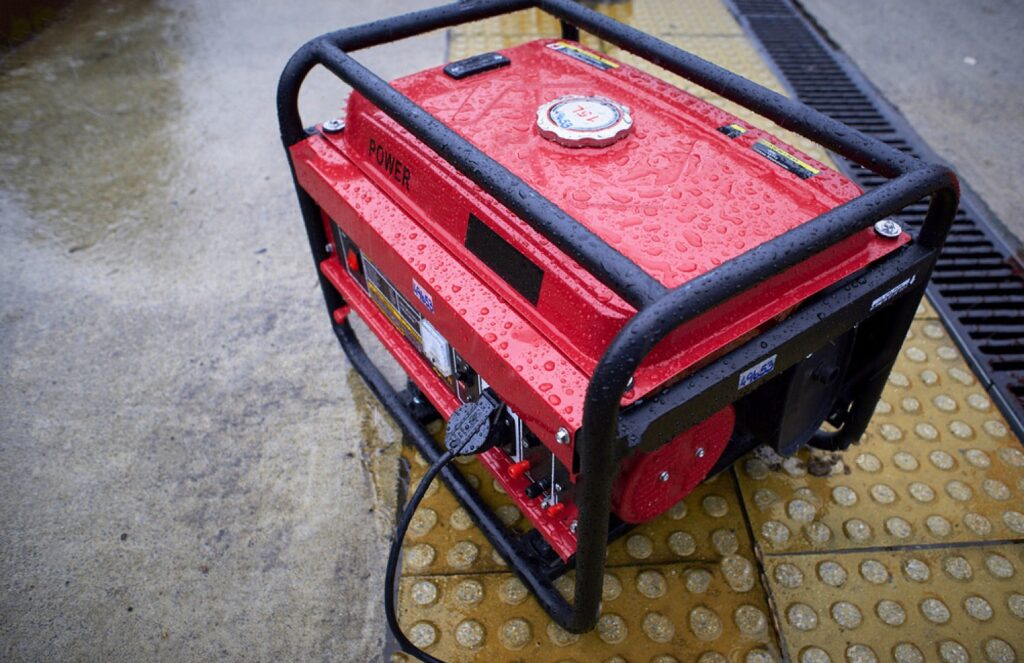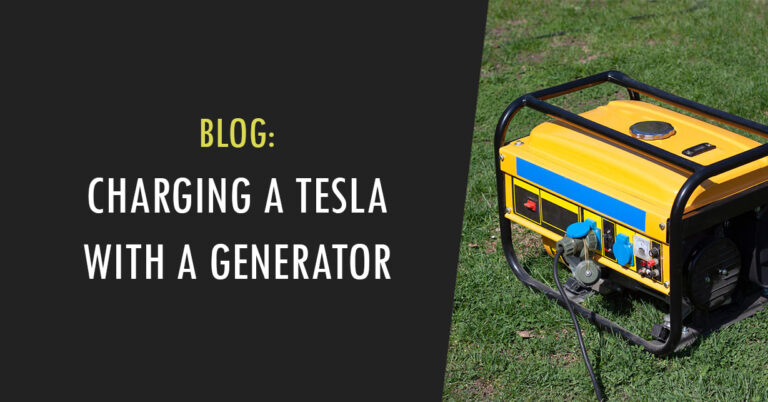Getting stranded on the road if your Tesla runs out of battery is a common fear for new owners. If you have a generator in your trunk, you might be tempted to use it to charge your Tesla and drive it to the nearest charging station.
But, can a Tesla be charged with a portable generator? Yes, but there are some things you need to know.
Can You Charge Your Tesla with a Portable Generator?
Yes, you can charge your Tesla with certain generators. You will need a properly grounded inverter that outputs a clean sine wave. You will also need a generator that offers a big amount of wattage. At least 1500W is recommended when trying to charge a Tesla from a generator.
It is not practical and certainly not recommended to do so. You shouldn’t rely on a generator even as a backup plan to charge your EV. Using a power generator makes the whole process of driving your Tesla more polluting than driving a conventional, gas-powered car.
Gas-powered vehicles convert their outputs directly into kinetic energy, which isn’t the case with a power generator. More specifically, a generator first uses gasoline to produce kinetic energy and transform that into electricity, which charges your Tesla. This energy is then turned into kinetic energy again when driving your EV. This is a very inefficient process of turning fuel into kinetic energy that moves your vehicle.
How To Charge a Tesla with a Power Generator
If you’ve determined that your generator outputs a clean, unmodified sine wave, and is properly grounded, you can start charging your car.
Your generator needs some time to warm up. Accordingly, set up the amps at the lowest settings using your dashboard monitor. Don’t add amps too quickly, or you’ll risk damaging your generator. Instead, slowly reach 28-30 A, and later, the generator’s maximum power.

Bear in mind that charging your Tesla will take quite some time. In particular, it can take more than 24 hours for a 4000W generator to fully charge a Tesla. You’ll only have to charge your Tesla to an extent and enough to get you to the closest power station.
Considerations for charging a Tesla with a generator
There are several crucial details you need to take into account before giving this method a try. Here are the most important factors:
Wave Type
The generator for your Tesla must output an unmodified, clean sine wave. All Teslas come with built-in protection that doesn’t allow charging from unstable power sources, as they are deemed an unstable and dirty source of power. Charging with a generator that outputs anything other than a clean sine wave may result in a damaging surge and harm to your car.

This means that you’re limited to inverter generators. Theoretically, all inverter generators have an unmodified sine wave output, but this isn’t always true. Many inverter generators feature a square wave, a modified sine wave, or a modified square wave. If so, your Tesla will consider this unstable energy and won’t allow you to charge it.
Tesla’s Regular Charging Conditions
Tesla cars come with special power outlets. They are compatible with NEMA outlets owing to their mobile connectors. Older tesla models featured a 14-50 and 5-15 connection, whereas newer vehicles are limited to Generation 2, 5-15 outlets.
Grounded Power Source and Wattage

The power generator you use to charge your Tesla must be grounded. Usually, your generator’s frame will serve as the grounding element. However, many generators don’t feature a true ground, which will be recognized by the charging system of your Tesla, preventing the car from charging.
You can purchase an adapter plug that will bridge the neutral and the ground with its resistor. Additionally, you can connect the floating neutral and the ground with copper wire. Also, some generators may require you to drive a metal rod into the ground and connect them.
As for the wattage, you’ll need a sufficient amount of power for your generator. You should go for a generator that outputs a minimum of 1500 W. Anything below that might be insufficient to charge your Tesla at all.
Outlets and Power
We’ve already mentioned some power outlet compatibility aspects, but we’ll go into more detail in this section. Essentially, your choice comes down to inverter generators with three different outlet types, whose charging power is limited for several reasons.
First, your outlet type is designed to transport only a certain amount of power. Second, your Tesla will always draw less power than the outlet’s threshold. Finally, power generators have certain power limitations that curb their power output.
Here are the three outlet types, their power ratings, and the performance you can expect from them:
- NEMA 5-20 – Rated for up to 20 A, 120 V, and 2400 W. They will power your Tesla for a couple of miles, meaning that they can be a reliable power source if you need to reach the closest power station. However, these outlets aren’t suitable if you want a power source that will last for a few days.
- NEMA 14-30 – This outlet type isn’t very common. The ratings are much better than the previous class and amount to 30 A, 240 V, and 7200 W. Due to the increase in power, you can expect your Tesla to have a suitable power source for a more reasonable period.
- NEMA 14-50 – You can only find these outlets in costlier generators. They have the highest ratings – 50 A, 240 V, and 12000 W. Since they are the most potent outlets, charging your Tesla with them will let you drive your car for longer.
How Much Power Can You Get from Your Power Generator?
Again, several factors will restrict the amount of power you get from your power generator. For instance, here’s how much power each adapter can draw from a generator:
| ADAPTER TYPE | MAX WATTS AND AMPS (GENERATION 1) | MAX WATTS AND AMPS (GENERATION 2) |
| 5-20 | 1920W, 16A | 1920W, 16A |
| 14-30 | 5760W, 24A | 5760W, 24A |
| 14-50 | 9600W, 40A | 7680W, 32A |
Moreover, here’s how much mileage you can get from your generator, depending on your Tesla model:
| GENERATION 1 ADAPTER | MILEAGE PER HOUR OF CHARGE (MODEL X) | MILEAGE PER HOUR OF CHARGE (MODEL S) | GENERATION 2 ADAPTER | MILEAGE PER HOUR OF CHARGE (MODEL Y) | MILEAGE PER HOUR OF CHARGE (MODEL X) | MILEAGE PER HOUR OF CHARGE (MODEL 3) | MILEAGE PER HOUR OF CHARGE (MODEL S) |
| 5-20 | 3 | 4 | 5-20 | 4 | 3 | 4 | 4 |
| 14-30 | 14 | 17 | 14-30 | 21 | 14 | 22 | 17 |
| 14-50 | 25 | 29 | 14-50 | 29 | 20 | 30 | 23 |
Considering the distance that your power generator can enable your Tesla to travel, you should think about whether charging is even worth the time. For example, if you’re using a NEMA 5-20 outlet, you can only get a recharge speed of about four miles per hour, which is almost the same as an average person’s walking speed.
Here are some additional tips for getting the best range with your Tesla.
When Should You Use a Power Generator to Charge Your Tesla?
To prevent your Tesla from using non-energy-efficient power sources, charge it with a generator only in an emergency situation.
For instance, if your Tesla loses power in the middle of the road and there’s a power outage, using a power generator may be the only way of getting back on track.
Charging your Tesla with power generator is inefficent and slow, but a viable option if there is no other alternative such as getting a tow back to a charging station.
Can You Charge Your Tesla While Driving?
It may sound tempting to extend your Tesla’s driving range by attaching it to a power generator while driving. However, this method isn’t safe at all for a number of reasons.
First, a Tesla won’t allow you to drive while you charge it, you may need to make some extensive modifications to the electrical and charging system of your car. This process can damage the electrical system and even void your warranty.
Another important consideration is that it is unsafe to have a running generation full of fuel running in your trunk. Also, where would the fumes go? Generators need to be run in an open space.
Overall, it is a really bad idea to charge your battery with a generator while driving. Leave that to certain stunt YouTube channels; do not attempt.
Final Thoughts
It is possible to charge your Tesla with a power generator but only properly grounded inverter generators with a clean, unmodified sine wave will work.
Additionally, while your chances of success are good, you should also plan how to proceed if you fail to charge your Tesla. For instance, you may not be able to resolve your grounding issues, leaving you with a useless generator. If you’re planning taking a long road trip, do not rely on a generator to charge your Tesla.
You might be better off waiting for a tow truck than wasting a lot of fuel charging your Tesla for several hours to get a meager amount of mileage.

